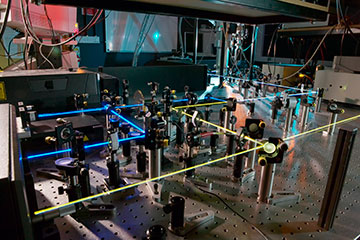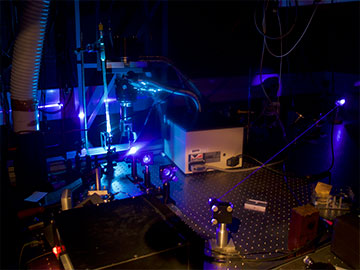Hyperfluorescent OLEDs that leverage two contrasting TADF emitters result in tripled external quantum efficiency compared with nonhyperfluorescent devices. [Image: Andrew Monkman, Durham University, UK]
Blue organic light-emitting diode (OLED) technology used for commercial applications, such as smartphone and TV displays, would benefit from higher efficiency, stability and color purity. One possible solution is hyperfluorescent OLEDs, which combine two different emitters such as thermally activated delayed fluorescence (TADF) and fluorescent emitters.
Now, researchers from Durham University, UK, have reportedly designed hyperfluorescent OLEDs that leverage two contrasting TADF emitters (Nat. Photon., doi: 10.1038/s41566-024-01395-1). They discovered that, by including a TADF sensitizer―previously dismissed as a poor emitter―the external quantum efficiency can be tripled compared with nonhyperfluorescent devices.
The next generation
Earlier generations of OLEDs are based on fluorescent and phosphorescent emitters. More recently, OLEDs have utilized TADF organic emitters, which significantly enhance performance. However, the wide emission spectra of TADF emitters result in low color purity, and inherent degradation processes reduce external quantum efficiency and device stability.
Hyperfluorescent OLEDs have garnered attention as a promising approach that may overcome the limitations of previous generations of devices. With a focus on blue OLEDs, Andrew Monkman and his colleagues aimed to understand the importance of the triplet up-converting sensitizer in optimizing efficiency, improving color purity and minimizing spectral overlap.
“In the latest Samsung OLED TVs, only blue pixels are now required, so anything that improves both the efficiency and color saturation of blue pixels is important,” said study author Monkman. The new OLED display architectures exclusively use blue pixels with external fluorescent color conversion layers and offer a 30% reduction in power consumption.
Building a better blue OLED
The researchers discovered that the molecular structure of the sensitizer profoundly affects the Förster resonance energy transfer (FRET) efficiency. In particular, the spiro-linked TADF molecule ACRSA has a rigid structure and, when used as a sensitizer, gives rise to hyperfluorescent OLEDs with an almost tripled external quantum efficiency.
New research indicates that green sensitizers can efficiently pump blue terminal emitters, thereby reducing device exciton energies and improving blue OLED stability. [Image: Andrew Monkman, Durham University, UK]
Sensitizers that have a more free-wheeling structure result in emission energy not being transferred by FRET to the terminal emitter, which loses efficiency and broadens the emission. In contrast, ACRSA had FRET efficiency optimized to nearly 100%.
“We found that to obtain the most pure blue, hyperfluorescence requires very homogeneous sensitizers," said Monkman. "We also found that ACRSA, which is a rather poor TADF emitter in devices because the radiative decay rate is very slow, actually acts as the best sensitizer because the slow decay rate means the Förster transfer wins completely.
Next, Monkman and his colleagues plan to focus more on hyperphosphorescence and a saturated, narrow-linewidth, deep-blue emitter system with an operating lifetime acceptable to industry.



